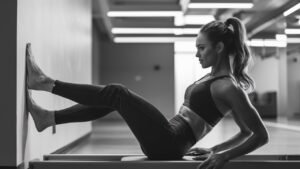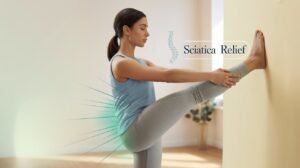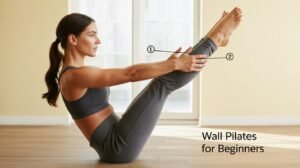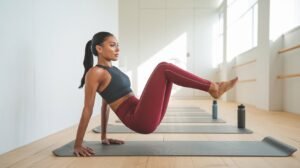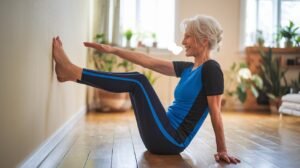Wall Pilates is a modern adaptation of the classic Pilates method, utilizing the stability and support of a wall to enhance traditional exercises. Central to both classic and Wall Pilates are the core principles of breath, control, and precision. These principles ensure that each movement is performed with maximum effectiveness and mindfulness. At Wall Pilates Workouts, we emphasize these foundational elements to help you achieve a balanced, strong, and flexible body. In this blog, we’ll delve into the core principles of Wall Pilates and explore how they can transform your fitness routine.
The Core Principles of Wall Pilates
- Breath
- Control
- Precision

1. Breath
Breathing is a fundamental aspect of Wall Pilates, promoting oxygenation, relaxation, and effective muscle engagement. Proper breathing techniques help you perform exercises with better form and efficiency.
Why Breath Matters:
- Increases Oxygen Flow: Enhances muscle performance and endurance.
- Engages Core Muscles: Deep breathing activates the deep core muscles, providing stability.
- Reduces Stress: Controlled breathing calms the nervous system and reduces stress.
Example Exercise: Wall Breathing Practice
- Stand with your back against the wall, feet hip-width apart.
- Place your hands on your ribcage.
- Inhale deeply through your nose, expanding your ribcage sideways.
- Exhale slowly through your mouth, feeling your ribcage contract.
- Repeat for 10 breaths, focusing on the movement of your ribcage.
2. Control
Control is about performing each movement with deliberate and mindful attention, avoiding any jerky or rushed motions. This principle ensures that you engage the correct muscles and prevent injuries.
Why Control Matters:
- Prevents Injury: Controlled movements reduce the risk of strain and injury.
- Enhances Muscle Engagement: Ensures that the target muscles are activated correctly.
- Improves Movement Quality: Leads to smoother, more coordinated movements.
Example Exercise: Wall Leg Lift with Control
- Stand with your side against the wall, one hand on the wall for support.
- Slowly lift your outer leg to the side, keeping it straight and controlled.
- Hold for a moment, then slowly lower it back down.
- Repeat 10 times on each side, focusing on smooth, controlled movements.
3. Precision
Precision involves executing each exercise with attention to detail, ensuring proper alignment and form. This principle enhances the effectiveness of the workout and helps develop better body awareness.
Why Precision Matters:
- Maximizes Effectiveness: Precise movements ensure that exercises target the intended muscles.
- Improves Posture: Attention to alignment helps improve overall posture.
- Enhances Mind-Body Connection: Fosters greater awareness of your body’s movements and positions.
Example Exercise: Wall Squat with Precision
- Stand with your back against the wall, feet hip-width apart.
- Slowly slide down the wall into a squat position, ensuring your knees are aligned with your toes.
- Hold for a few seconds, then slowly slide back up.
- Repeat 10 times, maintaining focus on precise alignment and form.
Integrating the Principles into Your Wall Pilates Routine
To fully benefit from Wall Pilates, it’s essential to integrate the principles of breath, control, and precision into your routine. Here’s a sample Wall Pilates sequence that emphasizes these core principles:
- Wall Breathing Practice – 10 breaths
- Wall Squat with Precision – 10 reps
- Wall Leg Lift with Control – 10 reps each side
- Wall Push-Up with Breath Coordination – 10 reps
- Wall Roll-Down with Precision – 5 reps
Instructions:
- Begin with Wall Breathing Practice to focus on breath and prepare your body for the workout.
- Perform Wall Squats with attention to precise alignment and form.
- Continue with Wall Leg Lifts, focusing on controlled, deliberate movements.
- Incorporate Wall Push-Ups, coordinating your breath with each movement.
- Finish with Wall Roll-Downs, emphasizing precision and controlled spinal articulation.
Tips for Practicing Wall Pilates
- Stay Mindful: Always be aware of your breath, control, and precision during each exercise.
- Start Slow: Begin with basic exercises and gradually increase intensity as you master the principles.
- Focus on Form: Prioritize proper form and alignment over the number of repetitions.
- Use Visualization: Visualize the muscles you’re working and the movements you’re performing to enhance precision.
- Consistency is Key: Regular practice will help you internalize these principles and see significant improvements.
Conclusion
Understanding and applying the core principles of Wall Pilates—breath, control, and precision—can transform your fitness routine, leading to greater strength, flexibility, and body awareness. These principles ensure that each movement is performed with maximum effectiveness and mindfulness, promoting overall physical and mental well-being. At Wall Pilates Workouts, we incorporate these foundational elements into our routines to help you achieve a balanced, strong, and flexible body. Embrace the power of Wall Pilates and experience the transformative benefits of breath, control, and precision.

